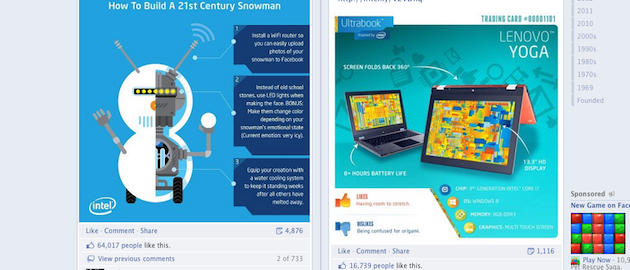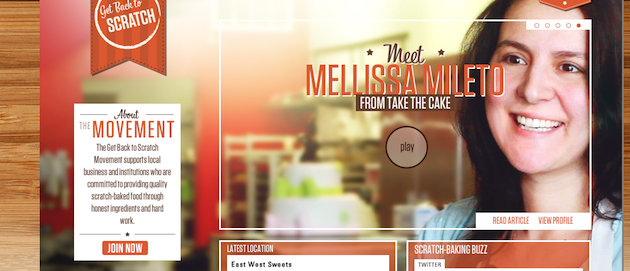If there’s one thing I’ve learned about designing social media experiences, it’s that they have to illustrate to audiences that we “get” them in order to engage them. The reason so many marketers are struggling to show solid ROI for their social media programs is simply because they aren’t designing their strategies specifically for the medium.
It’s not enough to clone the same content and interactions used in other media like websites, paid ads, and email newsletters. The keystone to your strategy should be recalling why you’re in business in the first place and remembering who it is that you are helping. Then you can begin thinking in a non-promotional way about how to elicit the unexpressed needs of your customer.
You’ll discover these needs through the stories your customers share, the causes they follow, the attitudes they exhibit, and the vocabularies they use. These needs will become the foundation of an experience design that is populated with more authentic human interactions. Social experience design done right makes me feel like I’m connecting with people, and I feel really good about my job. Here are a few examples of companies getting it right by actually touching their customers rather than treating them like touch-points.
Intel Makes Each Customer Feel Like They are a Part of Something Special

I have to admit, I’m not a big fan of companies using Facebook to hock their wares or blast their branding. To my surprise, however, I stumbled on Intel’s Facebook page and was all at once amused and impressed—feeling quickly, as I’m sure many customers did, like I was a part of something really interesting and wonder-filled. Intel accomplishes this feat through incredibly unique art and photography, along with product explorations falling under the personalized call to action: “What makes your computer special is what it makes possible-Go Do Something Wonderful.” I believe it’s this kind of engagement that has led Intel to claim more “Likes” on their page than all of their competitors (AMD, Microsoft, Google and Lenovo) combined.
Hobart, Traulsen, and Baxter Embrace Their Affinity Groups

I also have to admit that, like a lot of people these days, I’m a foodie. So when I was browsing some recent social media award winners, Get Back To Scratch jumped off the page at me. As it turns out, this site, created by a partnership of B2B food service equipment makers, won B2B magazine’s Best Use of Integrated Campaign by a nontech company, but it is much more than that.
The equipment providers support their business consumers by rewarding those who commit themselves to what’s perceived as an unmet need of their end consumers: quality food made with hard work and “honest” ingredients. This model is a growing one seen in other industries (healthcare in particular) that provides a “micro- support community” for users. In healthcare, these social communities support wellness by targeting those with chronic diseases. For affinity groups like foodies the stakes are less serious, but just as influential. Sites like these sponsor passion, and the resulting lift in goodwill ultimately sells more products.
Cisco Levels Up to Larger Societal Issues

Cisco’s “Human Network” messaging has always been my favorite, so I was overjoyed to see how they have recently evolved their brand to continue to push the human elements of technology. We are starting to see imagery in their videos and commercials that morphs the familiar vertical bars in their logo into stick people holding hands. It’s a clever treatment that is indicative of how Cisco is continuing to move the conversation from products and technologies up a level to larger societal issues.
Their Connected Life Exchange raises awareness about the value of networks through a series of stories, opinion pieces, and educational essays that demonstrate how technology is changing everything from government to sewer lines, all supported by a historical series of videos called “The Network Effect.” The six-episode series opens powerfully with a piece about how the rising penetration of mobile telephony by 10% in each developing country gives 600,000 more kids an education, increases the life expectancy of its citizens by 15 months, and adds $1.5 billion into the global economy.
“Bully” Fights for Its Audience

What if your distribution channel is threatened by product regulations? This example from the entertainment industry illustrates how a network of customers can be motivated to influence regulations when the product deeply resonates with them. The film Bully, a documentary about childhood bullying, had a limited release on March 30, 2012 and was hit with an R-rating for strong language from the MPAA. With an R-rating, the real audience for the movie, middle and high schoolers, would effectively be blocked from seeing it. The distributor organized a Twitter campaign that mobilized its potential audience and influential celebrities to pass along the message:
RETWEET PLEASE Did u know 13 million kids get bullied every year? I support @BullyMovie. Let’s make it a trend: #BullyMovie
The result? Dozens of celebrities Tweeted the cause, including Ellen DeGeneres, Anderson Cooper, and Kim Kardashian, along with major organizations including GLADD and Take Part. Alongside 500,000 petitioners organized by Change.org, the MPAA was influenced to reconsider and rereleased the film with a PG-13 rating.
Conclusion
So what’s the most important takeaway here? We’ve all read plenty of articles about being conversational, open, and honest with customers in social media. What I’m proposing is that we need to think about entire digital experiences from the social perspective and construct them with a strategy that uncovers the unexpressed needs of our users. Then we can address these needs in complete social experiences designed to make our customers feel something, whether that something is resonating with a personal mission, feeding a passion, or offering membership in something globally important. It’s only by engaging customers in these ways—by connecting with them as people—that we will realize the returns we all know are waiting for us.
Image of dog and duck courtesy Shutterstock.







